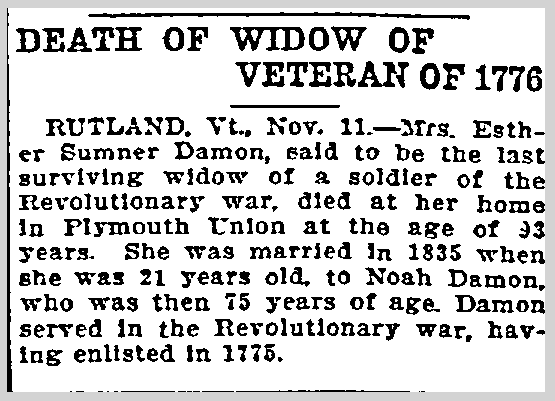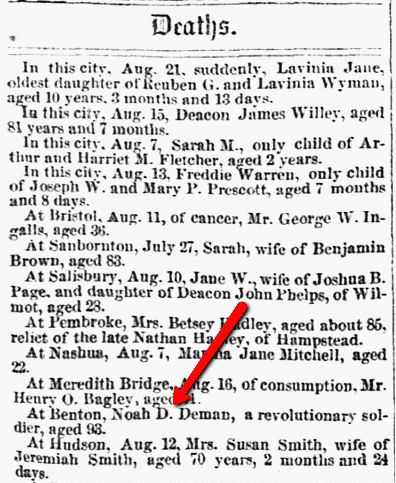Introduction: Mary Harrell-Sesniak is a genealogist, author and editor with a strong technology background. In this guest blog post, Mary writes about the last Revolutionary War pension being paid in 1906—131 years after armed conflict began between Great Britain and its American colonies.
It seems hard to believe, but the last Revolutionary War pension was paid in 1906—131 years after the Battles of Lexington and Concord began the American Revolutionary War in 1775. That link to our country’s birth ended with the death of Esther (Sumner) Damon, the widow of Noah Damon and the last widow of the Revolutionary War to receive a pension.
Esther died 106 years ago (in 1906), having married her spouse 6 September 1835 when he was 75, and she, 21.

Noah served as a private with the Massachusetts troops, and applied for a war pension 13 November 1848 as a resident of Plainfield, New Hampshire. He died five years later, as shown in this death notice found in a historical newspaper.

The first pension Act was in 1776, so why didn’t Noah receive a war pension until 1848?
One might assume he wasn’t eligible for the government pension benefits, failing to meet one of the many requirements imposed by the legislature, such as disablement, rank or length of service.
“In CONGRESS August 26, 1776.
…Resolved, That every commissioned officer, who shall lose a limb in any engagement, or be so disabled in the service of the United States of America as to render him incapable, afterwards, of getting a livelihood, shall receive during his life, or the continuance of such disability, the one half of his monthly pay, from and after the time that his pay as an officer, or soldier, ceases; to be paid by the Committee as hereafter mentioned…”
Damon’s pension application stated he might have applied earlier, but had been a resident of Canada and “ignorant of his right.” He wrote that he
“received a bayonet and wound in his right thigh, from the effect of which he has since suffered much pain and inconvenience the scar of which is very apparent to the present day.”
So how many pension acts were there?
Numerous—with each pension designed to accommodate the needs of soldiers and/or survivors.
Over time, the ranks of the public dole swelled—up to 1878, when Congress passed the final act (which also included the War of 1812).
It was an amazingly generous pension act, allowing a pension for just a minimum 14-day service for honorably discharged veterans, and imposing a short time period for the application process.
You could read about these pension acts for war veterans and their survivors in various historical sources, or you can delve into them yourself in GenealogyBank’s historical newspaper archives to see how these acts were presented to the public at the time they were enacted.
As an example, here is an old newspaper article describing the important pension act of 1780—the first to address the provision of war pensions to widows and orphans.
To help you with your Revolutionary War and War of 1812 pension research on your ancestors, here is a list of the dates for each pension act of Congress:
Pension Acts and Amendments
- August 26, 1776
- May 15, 1778
- September 29, 1789
- March 18, 1818
- May 15, 1823
- June 7, 1832
- August 24, 1780
- August 26, 1776
- May 15, 1778
- August 24, 1780 (first to address pay for widows and orphans)
- October 21, 1780
- March 22, 1783
- September 29, 1789
- March 23, 1792
- April 10, 1806
- March 18, 1818 (first to grant pensions for service only)
- May 1, 1820
- March 1, 1823
- May 15, 1828
- June 7, 1832
- July 4, 1836
- July 7, 1838
- July 29, 1848 (widow marriage requirement prior to January 2, 1800)
- March 9, 1878